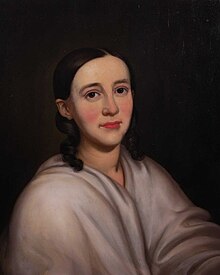Mary Blanchard Lynde


Mary Blanchard Lynde (December 4, 1819 – June 26, 1897) was an American philanthropist and social reformer, active in all of the progressive women's movements in Wisconsin.[1] She was the co-founder of the Wisconsin Industrial School for Girls, and the first woman in Wisconsin to receive a state office appointment.[2]
Biography[]
Mary Elizabeth Blanchard was born in Truxton, New York, December 4, 1819. Her father was Azariel Blanchard. Her mother was Elizabeth Rabcock, a native of South Kingstown, Rhode Island.[3]
She was educated principally in the Albany Female Academy, where she was graduated in 1839, taking the first prize medal for composition, which was presented by the governor of the State, Hon. William H. Seward.[3]
After marrying Hon. William Pitt Lynde, she spent most of her married life in Milwaukee, Wisconsin.[3] The couple had at least two children, a son, S. A. Lynde, and a daughter, Mrs. Montgomery Meigs.[4]

In the 1850s, Lynde was a co-founder of Milwaukee's Ladies' Benevolent Society and in the beginning of the following decade, of the soldiers' aid society. In the 1880s, Lynde was a national leader on the issue of prison reform.[5]
She was appointed a member of the Wisconsin State Board of Charities and Reforms, while Governor Lucius Fairchild was in office. She was the first woman to hold such a position. She spoke much in public, chiefly before legislative committees in behalf of charitable institutions, but also before State conventions of charities. She read papers in the meetings of the Association for the Advancement of Women in Chicago and Boston, and her ideas were so practical and forcible as to attract unusual attention. She was engaged in looking after the general interests of the Wisconsin Industrial School for Girls. She was also a member of the Woman's Board of Managers from Wisconsin to the 1893 World's Columbian Exposition.[3][2]
Lynde died at her home in Milwaukee, June 26, 1897.[1]
References[]
- ^ a b "Mrs. Mary Lynde". Chicago Tribune. 27 June 1897. p. 6. Retrieved 3 March 2021 – via Newspapers.com.
- ^ a b McGlynn, Ann (10 November 1996). "Right to vote was long, hard struggle". The Journal Times. Racine, Wisconsin. p. 13. Retrieved 3 March 2021 – via Newspapers.com.
- ^ a b c d Willard & Livermore 1893, p. 479.
- ^ "Funeral Service This Afternoon". The Rock Island Argus. 5 September 1894. p. 5. Retrieved 3 March 2021 – via Newspapers.com.
- ^ McBride 2014, pp. 169, 171.
Attribution[]
 This article incorporates text from this source, which is in the public domain: Willard, Frances Elizabeth; Livermore, Mary Ashton Rice (1893). A Woman of the Century: Fourteen Hundred-seventy Biographical Sketches Accompanied by Portraits of Leading American Women in All Walks of Life (Public domain ed.). Charles Wells Moulton.
This article incorporates text from this source, which is in the public domain: Willard, Frances Elizabeth; Livermore, Mary Ashton Rice (1893). A Woman of the Century: Fourteen Hundred-seventy Biographical Sketches Accompanied by Portraits of Leading American Women in All Walks of Life (Public domain ed.). Charles Wells Moulton.
Bibliography[]
- McBride, Genevieve G. (20 May 2014). Women's Wisconsin: From Native Matriarchies to the New Millennium. Wisconsin Historical Society Press. ISBN 978-0-87020-563-7.
External links[]
 Works related to Woman of the Century/Mary Elizabeth Blanchard Lynde at Wikisource
Works related to Woman of the Century/Mary Elizabeth Blanchard Lynde at Wikisource- Oval portrait painting of Mary Blanchard Lynde
- "Speaking with an Equal Voice. The Reform Efforts of Milwaukee's Mary Blanchard Lynde", by Ellen D. Langill, Wisconsin magazine of history: v. 87, no. 1, autumn 2003, ISSN 1943-7366
- 1819 births
- 1897 deaths
- People from Truxton, New York
- People from Milwaukee
- Philanthropists from Wisconsin
- American social reformers